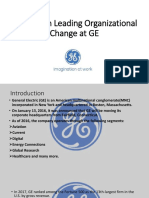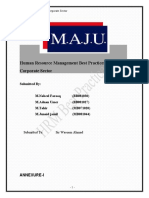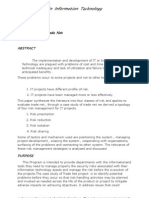Jack Welch
Jack Welch
Uploaded by
nitin_yogeshCopyright:
Available Formats
Jack Welch
Jack Welch
Uploaded by
nitin_yogeshCopyright
Available Formats
Share this document
Did you find this document useful?
Is this content inappropriate?
Copyright:
Available Formats
Jack Welch
Jack Welch
Uploaded by
nitin_yogeshCopyright:
Available Formats
Jack Welch And the Motivation of...
GROUP MEMBERS :
1)Nitika Jain 2) Ragini Jain 3) Sanket Pawar 4) Preetish Pakhale 5) Anchal Kandoi 6) Shishir Samant 7) Pranali Adani
294 292 240 237 293 238 274
Hypothesis Jack Welch has made General Electric Corporation (GE) into one of the worlds most successful companies. Through the use of goal setting, empowerment, and communication Welch transformed a complacent behemothinto an energized company ready to face world competition. Through an analysis of the techniques employed byWelch one can gain a better understanding of how to motivate outstanding performance in any organization. Introduction When Jack Welch became CEO of GE in 1981, he set out to reenergize one of Americas largest companies. Through a revision of GEs mission and values, Jack Welch grew GE from a $24+ billion company to into a $74+ billion company, ready to facecompetitors and future challenges. Welch realigned goals and motivation, forcing managers to stretch to previouslyunknown limits. Any company not number one or two in their industry was divested or closed and though sometimesperceived to be a destroyer, he restructured GE into one of the worlds most staid corporations. Jack Welchs management and motivation approach included three main areas: 1.) Goal setting and preparing the company on a corporate level for its competitive challenges; 2.) Empowering employees at all levels of the organization; and 3.) Communicating his new goals and visions through the entire organization, using such tools as extensive trainingprograms, newly formed teams and 360-degree review processes. Different aspects of Jack Welchs management tactics, in terms of motivating employees to bring about change,can be compared and contrasted with some of the cases analyzed during this quarter. These includeempowerment tactics used by Anita Roddick; de-powerment tactics used by Lyndon Johnson (LBJ); a reduction ofbureaucracy and secrecy, as well as an opening of communication channels, such as advocated by Kissinger;issues related to benefiting millions at the cost of thousands and acting for the achievement of some greater good,as discussed as part of the Robert Moses case; and communication and mass motivation issues as discussed inthe Xerox cases. Some of Welchs other tactics can be directly related to topics discussed by Michael Dulberg, including an analysis of resources, sources of power, allies, locations within communication networks,reciprocation, formal authority, reputation, and performanceGoals & Competition.
An underlying theme for Jack Welchs tenure as CEO of GE was his use of goal setting to motivate higher levels ofachievement throughout the company. Welch set company- wide goals, as well as specific performance objectivesfor individual companies and divisions. He often supplemented his goal setting by creating a sense of competitionwithin the organization, as well as against all competitors.Early on in Jack Welchs career with GE, he exercised the use of goals and competition to drive above averageperformance. In 1968, at the age of thirty-three, Welch was promoted to the position of General Manager of GEsLEXAN and NORYL plastics lines. His goal was to convince the market that both Lexan and Noryl could be used asreplacements for more traditional materials such as steel or glass. Typical GE protocol would have been toseparate the two lines and to position each for different markets so that no sales-territoryoverlaps occurred. Bucking the old protocol, Welch told each group of sales people to attack the entire market and compete head-to-head. The strategy worked well for all parties. With Welch at the helm, GE Plastics earnings grew at 34% annually,compounded revenues in 1991 reached $4.7 billion and employees felt they were part of a winning, competitiveteam. Similarly, in 1980, when Jack Welch was elected to the position of CEO for GE, he continued his competitivestrategy to motivate performance in business units by requiring them achieve either number one or number twostatus in terms of market share in their respective fields. Many of GEs businesses were already number one ornumber two in their market areas and yet Welch and his management team continued to set goals, which would notonly keep them in those positions, but which would further grow their lead. Constantly striving to stay ahead of his competitors stokes Welchs competitive fires to achieve GEs leadershipposition and to drive constant growth, Welch required goals and stretch-goals to be set throughout the organization.His stretch-goal philosophy developed from his readings of Johannes von Moltke, a 19th century Prussian generalwho outlined strategy as something with a simple, far reaching set of goals which could be achieved through adynamic organization not limited by strike guidelines. Welch preached a philosophy he called planful opportunism. Michael Dulberg, Steven SprindisJudson, PaschenSachaStawskiwhereby GE employees were given an over-reaching stretch-goal and permitted to do whatever it took to reach thetarget. He was able to demonstrate the success of planful opportunism with the expansion of LEXAN into theworld market. In the early 70s LEXAN was only produced and marketed in the U.S. Welch created a stretch-goalof dramatically expanding LEXANs sales into the world market. He secured the necessary $55 million funding tobuild a plant in Holland and soon thereafter succeeded in growing global sales significantly. The stretch-goalsucceeded, and in 1977 GE generated 26% of its revenues overseas. Not only has Jack Welch demonstratedplanful opportunism, but many of his senior leaders have chosen to adhere to the same philosophy.
Welch continued to use stretch goals to drive performance throughout the company. In one instance, Welchchallenged John Trani, the head of GE's Milwaukee based GEMS unit, to increase production speed by a factor offive. Trani's pursuit of this goal, while never quite reaching it, resulted in strong growth in both production and sales.In another example, Welch required the newly hired head of productivity, William Sheeran, to achieve 5% annualproductivity. Sheeran never attained the lofty goal, however his efforts resulted in increasing productivity to over2%. Finally, Welch used the same technique in an effort to improve product quality. Welch introduced GE to SixSigma, a defect reduction program. GE had been operating at 3.5 sigmas, but that wasn't enough for Welch, hewanted six sigmas. In all these cases, Welch consistently set far reaching goals in an attempt to move the company in thedirection he wanted. While not all goals may be reached, Welch reinforced the notion that advancing towards thosegoals was still considered success and rewarded managers accordingly. Another way of looking at Jack Welchs attitude towards management and motivation in terms of goal setting maybe compared to what is often referred to as the boiling frog syndrome. When a frog is placed in a pot of water inwhich the heat is slowly turned up, it will not recognize the rising temperate, remain complacent and eventually boilto death. Analogously, Welch sees GE as being the frog placed in the world pot of water. The water temperaturearound GE is slowly rising and GE is getting hotter. If GE does not react to the temperature increases related tocompetition, it will boil to death as does the frog. If GE leads the market however, throws itself right into the pot ofboiling water, it will jump right back out, just like a frog would do, if thrown directly into a pot of boiling water. WhileWith the push for quality has come a new warrior class within the company: Green Belts, Black Belts and Master Black Belts the new management samurai of global competition If you dont have a belt, you wont get promoted [and] Welch hastied 40 percent of each managers bonus to progress toward quality results.MichaelDulberg Steven SprindisJudson PaschenSachaStawskiothers may sit and wait complacently, slowly letting the heat rise around them, Jack Welch prefers throwing GE rightinto its challenges, shocking the system and forcing immediate reactions.The people with whom I have been associated have worked hard, enjoyed it more, although not alwaysinitially, and in the end, gained increased self- respect from accomplishing more than they previously thoughtpossible.
Welch realized that he could motivate higher levels of performance by setting goals that were much higher than themanagers would have set for themselves. These stretch-goals often caused the managers to outperform theiroriginal targets. The phenomenon that helped increase performance was the slope of satisfaction joined withinternal competition focused on gaining a leadership position in world markets. The slope of satisfaction refers to the incremental level of satisfaction a persongains for each additional unit of effort towards a goal. The slope increases as the person approaches the goal.Therefore, as a person gets close to reaching a goal he is more motivated to try to close the gap between thecurrent level of performance and the target. Furthermore, he is likely to continue striving for the goal because theincremental satisfaction gained is thought to be worth the additional effort. However, if the goal is seeminglyunachievable, the likelihood of the person undertaking or completing the task is reduced. Relief and stress oftenaccompany goal setting. Relief is felt if the goal is achieved, but stress is encountered while trying to reach the goalor if the goal is not reached. The Washington Post, March 28, 1997, Talking Management with Chairman WelchControl Your Destiny orSomeone Else Will-Welch played upon emotions in the application of his goal setting. Because Welch set such extreme stretch-goals, he needed to incent effort toward these seemingly unattainable targets. He rewarded people by giving .Bonuses if they made great progress towards the goals, even if they did not reach them. This succeeded in drivingpeople to work beyond their original goals and even if they did not reach the stretch goals Welch often recognizedthem for superior performance. Employees realized that even though they often did not reach the stretch goals,they still performed at their highest possible level and therefore enjoyed personal satisfaction, (as understood byMaslow in his hierarchy of needs) in their attempts to reach the goals.
Empowerment When Welch took over GE, he had a vision of creating an organization where people at all levels could be heldresponsible for their own work, and in the end make decisions for the betterment of their job. The goal was not to Jack will chase you around the room, throwing arguments and objections at you Then you fight back until he lets you dowhat you want --- and its clear youll do everything you can to make it work. Its a ritual. Its like signing up.Slope of satisfaction: a person starts toward his goal at the bottom left end of the curve moving upward and tothe right toward the stretch goal. The slope of satisfaction can be demonstrated by noting that the level ofsatisfaction (distance on the Y axis) between points A and B is equal to the level of satisfaction between pointB and the Normal Goal. However, the effort exerted (distance on the x axis) to get from point A to B is muchgreater than the effort exerted to get from point B to the Normal Goal. Therefore, as a person gets closer to agoal the incremental satisfaction increases for each additional unit of effort. This helps drive a person to reachhis goals.
Welch characterized this as creating boundary-lessorganization inwhich empowered employees were self- directed and motivated to effectively reach their goals.When Welch became the CEO of GE he found that the company was still organized the way it had been when GEwas founded near the turn of the century. Specifically, it was represented by an overwhelming nine layers ofmanagement between the shop floor and the CEO. This bureaucracy lead to an unresponsive, inward focusedcompany whose employees found great difficulty in communicating with one another. In fact, if GEs massive coststructure was not dramatically restructured, analysts projected that GE would become unprofitable by the end of1982.Welch addressed this issue by eliminating whole layers of management, consolidating overlapping jobs and business units, and forcing employees at every level totake more responsibility for their own work. If something was not absolutely necessary they eliminated it (very muchlike Xerox did in Dining at the Quality Restaurant). They stopped gathering unnecessary financial data andeliminated unnecessary reports. In the past, it had not been unusual for business managers to request daily reportsthat contained so much detail that the reports often produced a 12-foot high stack of paper. The sheer mass ofdetailed information made a mastery of the details impossible thereby rendering the information relatively useless. In the plant equipment operators became responsible for the quality of their own work, reducing the need forinspectors. In effect, employees were given the ability to eliminate those aspects of their job that were unproductiveand thus unnecessary. An important aspect of this has been the Work-Out, which has opened the communicationchannels necessary to help bring about innovative change (once again very much comparable to the training campsintroduced by Xerox in its attempts to reinvent itself). The Work-Out has been an empowerment concept greatly favored by Welch. Thousands ofGE employees get an opportunity to get together and share their ideas, thoughts and know-how, while building andfostering a more creative and team oriented atmosphere. The Work-Out encourages communication andaccountability with the ultimate goal being to drive above average team performance. By providing each teammember with the opportunity to contribute his ideas to the decision making process, Jack Welchs hoped to a former GE executive remembering being in the box with Jack Welchstimulate individuals to constructively challenge their bosses and promote a more motivated workplace. AllWork-Outs included follow-up meetings where previous commitments were discussed and accountability was enforced.Empowerment has been a two-way street. Employees have received the satisfaction of being able to air theirconcerns, while the company has greatly benefited from insights shared in the Work-Out. Under Jack Welch, GEbegan to realize that human beings are not machines and that each person has the potential to enhanceproductivity. Knowing how to use this resource can not only give the company a competitive edge, it can make eachemployee feel more important in the production process and thus more motivated.The only way to be more competitive was to engage every mind in the organization We hired the armsand backs and legs of people for
years, and we never knew the brains came for free.We proved that productivity is not a matter of cut and burn. It has nothing to do with whips and chains. Itsa never ending process thats based on empowerment. Its what happens when you get people excitedabout finding solutions to their problems. Empowerment drives favorable performance results for the employees and the company. An analysis ofempowerment as a management strategy highlights the potential improvements that can be made when you takefull advantage of the thoughts and ideas of all employees. The following is a list of ways of empowerment that can benefitan organization: 1. By empowering people, an organization gives employees the ultimate responsibility for theirown work. If they share the companys goals, they do not need much supervision. Cost will bereduced and layers of management will become unnecessary. 2. Employees become motivated to perform their jobs optimally. The old managerial habit ofimposing ideas on people has the result of turning those ideas into rules, stripping them of theirvitality. When a person develops his own ideas for how the work should be done, he will takeownership of his work and will perform that work with energy and enthusiasm. Welchunderstood that the power of command could not get him the loyalty he sought. He strove toliberate the minds of his subordinates and let them come up with the best ideas for getting thejob done. 3. Large productivity improvements will often accompany the empowerment of employees. Foryears management had assumed that they always knew the best ways to do things. Theyforced workers to do things the way they wanted, so the workers succumbed to the wills oftheir bosses and did as they were told. However, what management often overlooks is the factthat the workers, who spend much more time than management actually doing the work, havegreat ideas for improving the processes and productivity of the work they are performing.When given a chance to implement these ideas, the company will often experience largeproductivity improvements. This point was illustrated in the Ingersoll-Rand case we studiedduring the quarter. When Ingersoll-Rand was trying to improve their grinder they solicited theinput of all members from design to production, resulting in a revolutionary new tool design. 4. The organization will be able to implement new ideas faster and will be much more responsiveto the market. In the old GE, ideas had to be approved by many layers of management andhad to be entombed in facts and research if they had any chance of being implemented. In thenew GE, the person who comes up with the idea will have much more power and latitude toimplement the idea without having to battle the bureaucracy.Although it is difficult to measure the results of empowerment, GE believes that the success of the company in thefuture will prove that it was the right decision to make. The key question therefore is to find out how leaders likeWelch decide that empowerment is the right strategy and how they in general decide if it is
the right strategy toimplement at their companies.One way to decide on this is to envision a very hierarchical organization and an empowering organization. Ourstudies of Lyndon B. Johnson are a demonstration of a very authoritarian organization (proxy for the characteristicsof a hierarchical organization). Johnson did all of the thinking and expected his subordinates to do exactly what hetold them. He motivated his subordinates through fear, intimidation, and need. He hired them to do his bidding, notto think for themselves. In contrast, an example of an empowering company is the Body Shop. Anita Roddickbelieved that she could get the most out of her employees if she told them of her vision but then encouraged freethinking within the organization. The result of her philosophy is a group of very happy and motivated employees anda creative and customer focused organization. Though Lyndon Johnson may have been successful in some terms,there can be little doubt that, especially in todays society, most would prefer to work for an organization such as theBody Shop, where employees feel that their knowledge is being leveraged and combined in the most useful way.Based on this, it seems that empowerment (combined with some form of accountability and goal setting) would bethe clear choice for most organizations, especially very large organizations. No matter how intelligent a businessleader may be, he/she cannot plan to make all of the decisions for the company by himself/herself and still expectthat the company will be successful. Todays leaders must learn to nurture the creativity and intelligence of theiremployees if they are going to optimize the performance of their company. Jack Welch has done just that-CommunicationBoundary-less behavior and the elimination of unnecessary communication filters which are the key phrases to describeJack Welchs attitude towards communication. He encourages input from every employee, from the factory floor to the executive suite. To facilitate goal setting and empowerment within GE, Welch needed to establish clear lines of communication in the organization. He realized that employees come to GE with many different experiences andbackgrounds. He did not want to take away from the benefit of those various backgrounds, as much as reshapethem with GE philosophies. This is not to say that he wanted a workforce of robots. Just the opposite actually, hewants free thinkers. One of his objectives was to motivate people to think outside the box and challenge the statusquo. Open communication channels between Welch and his employees have been an important tool in this regard. These channels work in both directions, giving employees the ability to air their concerns and work towards aconsensus for action. They also help motivate employees, because once again employees feel that they aredirectly contributing to the success of the company.Welch is a proponent of facing reality, even when doing so is uncomfortable. He asks employees tocommunicatecandidly, even when doing so may sting. He has done everything in his power to communicate directly withemployees, including face-to-face meetings with subordinates as often as possible and participating in the Work-out. Another major component of Welchs communication philosophy has been hisapproach to the training of management.
Education and the Crotonville training center are a critical part of Jack Welchs communication philosophy at GE.Crotonville is no ordinary training center, though. In addition to lectures, attendees participate in team buildingexercises and mandates to tackle real GE problems. Welch uses Crotonville as a hub for communicationthroughout the GE organization. At Crotonville, all GE managers are indoctrinated with the GE goals and valuesystem. They are allowed to be frank with their opinions and concerns, while challenging policies and strategies ofthe company. Crotonville is the place where mangers learn about GE and get to experience the face-to-face debateand problem solving that is a cherished part of GEs culture. You cant say hello to Jack without it being confrontational. If you dont want to step up to Jack head-to-toe, belly-to-belly, and argue your point, he doesnt have any use for you. Industry Week magazine estimated that Jack Welch spends 30% of his time on leadership development, he eventeaches a development program at Crotonville for senior leaders once a week. Once exclusively attended by highGE executives, it has been expanded by Welch to receive 5,000 GE employees annually, including everyone hiredas manager or promoted to that rank. Every three weeks or so Welch choppers over to pitch his ideas to a newgroup and then debate them, roughand-tumble, in an amphitheater called the Pit New managers, for example, come to Crotonville about six months after their promotions time enough forthem to have made mistakes. They come with critiques of their performance from subordinates andsupervisors. They learn what theyve being doing wrong and promise to change. They discuss issues inteams, partly so they know theyre not alone in their experience. Although Welch used Crotonville as a hub for communication, he also wanted to open up all other available communication channels. The purpose was to allow those who were doing the work to get in contact with anybodythat would help them get the job done. If people were to be empowered they should not be crippled by lack of communication. One of the first things Welch did to increase communication was to cut out all managers that simply gathered information from their subordinates and passed it up the line to senior management. Welch used to go directly to the source when he wanted a question answered, so he did not want middle management standing in the way of such direct communication. By gaining such a great deal of access to personnel throughout the company employees had the ability to perform their jobs much better and were motivated by their successes. Another valuable and motivating communication channel that Welch opened up was between a boss and his subordinates. Employees spend time directly with their bosses and are given very clear information about successes or failures in their work, including being told if supervisors think they would be better off elsewhere.Employees are also allowed to evaluate their bosses. A better understanding of job responsibilities and performance combined with the ability to be a participant in the evaluation process have been instrumental in motivating employees and gaining their support during periods of massive restructuring and ever farther stretching goals.
As another cog on the communication wheel, Welch instituted a 30-odd member Corporate Executive Council(CEC). This council has no formal authority, but has come to function effectively as GEs political center. They are Welchs team of managers who meet regularly to discuss, debate and argue about the future of individual business units. One of the CECs functions is to serve as the main nerve center, ensuring that best practices arecommunicated throughout the company. Welch has gone further still, though, by establishing an additional globalbest practices program, which has opened the communication channel for GE with outside companies. GE scours the world for companies which are better than GE itself at some specific aspect of business and thenasks to pick their brains. In return GE promises to share with them the knowledge it gains
As such, GE not only looks for diverse ideas internally, but also goes outside its normal scope to further improve itself. Once again communication lines were opened as a two-way street. Information is sought after, but also being shared with others, Employees are motivated by the belief that they are an active part in making GE number one, while outsiders are motivated to work more closely with GE for their own future benefit. Internal communication is further facilitated and encouraged through an additional level of personal responsibility to one another. Crotonville, the Work-Out, The Pit and all the other training programs at which managers from different units get together serve the additional purpose of bringing them closer to each other personally, as advocated by Cialdini. Instead of receiving an anonymous help request from some other department, managers can now pick up the phone and call a rafting partner they met in Crotonville. Similarly, someone will be far more inclined to share information and assist another manager they know personally, rather than someone who has sent them a memo,which was perhaps forwarded through a multitude of bureaucratic layers before reaching the addressee, as may have been the case in the old days and as illustrated by the inefficiencies described in the Xerox case, The Quality Restaurant. Similarly, the Crotonville system provided a uniform pathway to all employees, away from the officeand in a different environment, yet designed so that all employees would learn a similar set of principles and values. Crotonville prepares managers for success at GE. Communication is extremely important for the success of GE. Like many great leaders, Welch has realized the value of good communication in an organization. He flattened the organization to take away any communication blockers. Then he set up Crotonville as his communication
hub, and established the CEC as the political center forthe company. He also set up 360degreereviews to let the employees know exactly where they stand in the organization. Welch has seen this communication as a major part of the force motivating people in their dealings with one another and in their attitude towards work and commitment to the organization. Unlike Henry Kissinger who coveted private information, or Lyndon Johnson who intimidated his workforce and fought to break their willpower, Welch has encouraged open communication and has challenged employees to think for themselves and stand up for what theybelieve. He believed that any employee who would argue his way through with him in the Pit, or in any other discussion, would be more dedicated to their own argument later own, doing everything in their power to make it work Criticisms Up to this point we have focused on the benefits from Welchs motivational techniques, but have neglected to mention the criticisms. Although we will not linger on the negative aspects of his tactics, they are nonetheless worth mentioning. Like Robert Moses, Welch is a man who has benefited millions, while devastating thousands. He has succeeded in making GE a successful company for its shareholders, but has destroyed thousands of families through the mass layoffs he instituted. Welch strongly believes that stretch-goals improve performance. Although he is probably correct, there are also costs involved cost. The side of stretch-goals we did not explore earlier is the feelings of stress and failure that accompany results that do not meet the goals. If people are always working towards stretch-goals they will wear themselves down and will likely start showing less progress towards the goals than previously thought. A great deal Managing with Power Politics and Influence in Organizations, of stress will accompany the shortfall in goals. In addition, there may be occasions when employees will feel as if they have truly reached their maximum capacity. Unions, for example felt that Welch kept on demanding more andmore at their workers expense, basically telling them to shape up or ship out, earning him the nickname Neutron Jack, among others. A negative aspect of empowerment stems from people who do not want to be empowered. Union workers are often happy to take on more responsibility, but those who distrust management do not think they should have to do any more than their usual assignments. Welch had assumed that all people want more responsibility, but the fact is that many people do not want any more responsibility. Many workers reason that if they had wanted to have more responsibility they would have become managers. A criticism of Welchs communication style is that he is too open and too confrontational. Welch strives to build self-confidence in his managers, but his communication style will often cause people to lose self-confidence in themselves. Open communication channels work well
when they are used to motivate performance and increase employee morale, but when they are used to intimidate they will have the opposite end in low self esteem. Conclusion Jack Welchs attitude towards management boils down to a few very simple ideas: breaking down hierarchies, ensuring free information flows throughout the organization, and encouraging people to talk, listen and be open to new ideas. When he first became a GE vice president at the age of 36, he stalked out on the plant floor, or picked up the telephone to deal directly with anyone at any level when a problem came up and that is the organization Jack Welch has attempted to build in terms of communication. Welch succeeded in transforming a complacent behemoth into an energized company ready to face world competition. By flattening the organization and by removing unnecessary layers of bureaucracy, he liberated employees and empowered them to make decisions and effect their jobs, as well as the company as a whole. At the same time, he relied on stretch goals and the slope of satisfaction (as previously discussed) to further push the company to new levels of achievement. An additional sense of empowerment was relayed through various communication, training and motivation mediums, such as the Work-Out, the Pit, the Corporate Executive Council and other special project teams. Foremost he underlined his words with accompanying actions and an exemplary attitude, avoiding the well known saying that words by themselves are empty. Through the use of 360-degree review processes, appropriate bonus schemes and structural organizational changes, Welch created and opened communication channels at GE, allowing for unprecedented networking, teamwork, and openness to take place at GE. All of these factors combined to form a motivating force for the employees of GE. This motivation in turn has lead to a decade of outstanding performance by Jack Welch and General Electric Corporation. Six Sigma quality means the virtual elimination of defects from every product, process and transaction this Company engages in every day around the globe. A Six Sigma quality level generates fewer than 3.4 defects per million operations in a manufacturing or service process. It has been estimated that less than Six Sigma quality, i.e., the three-to-four Sigma levels that are average for most U.S. companies, can cost a company as much as 10-15% of its revenues. For GE, that would mean $8-12 billion. Six Sigma quality is already becoming part of our culture and defining how we work. The Six Sigma process is a very specific scientific methodology of measuring, analyzing, improving and controlling every process we engage in, from making jet engine blades, to executing a credit transaction with a customer, to minimizing "dead air" between segments in broadcasting. It involves enormous amounts of training, with thousands of "Green Belts," "Black Belts" and "Master Black Belts" leading projects, teaching, and widening the circle of involvement in the quality initiative throughout GE.
The methodologies of Six Sigma we learned from other companies, but the cultural obsessiveness and allen compassing passion for it is pure GE. The intensity level involved in our decade-long struggle to achieve a boundary-less culture now seems "laid-back" compared to the near monomania with which we are approaching Six Sigma quality. Forty percent of every manager's bonus is tied to his or her progress on quality results. Quality is the top item on every agenda in every discussion in every business in this Company. For leaders who do not see how critical quality is to our future--like leaders who could not become boundary-less during the 1980s--GE is simply not the place to be. The momentum of the Six Sigma initiative is unprecedented. From launching this initiative in late 1995, with 200 projects and massive training, they moved to 3,000 projects and even more training in 1996; and undertook 6,000 projects, and still more training, in 1997. The $200 million they invested in 1996 has already returned nearly that much in quality-related savings. The additional $300 million they invested in 1997 delivered some $400-500 million in savings, producing an additional $100-200 million in incremental margins. This snowball will picked up size and momentum in terms of people trained, projects completed, and customer and employee satisfaction--all driving sales and net income growth.
You might also like
- General Electric's Two-Decade Transformation Case StudyDocument7 pagesGeneral Electric's Two-Decade Transformation Case StudyBradNo ratings yet
- Managing Finance and AccountsDocument18 pagesManaging Finance and AccountsKritagya ShresthaNo ratings yet
- Questions Answers of Case StudyDocument4 pagesQuestions Answers of Case StudyAmit Kumar100% (1)
- Google's Vision Statement: Generic Strategy and Intensive Growth StrategiesDocument3 pagesGoogle's Vision Statement: Generic Strategy and Intensive Growth Strategieshiral baidNo ratings yet
- Leading Change at Simmons CollegeDocument14 pagesLeading Change at Simmons CollegeDana Hlaine HtetNo ratings yet
- CW1 - 1500words AssessmentDocument8 pagesCW1 - 1500words AssessmentarsalanNo ratings yet
- Creative DevianceDocument2 pagesCreative DevianceSKSAIDINESHNo ratings yet
- Case Study Group 3.2Document17 pagesCase Study Group 3.2Karl Pepon Ayala100% (1)
- Your Approach To Hiring Is All WrongDocument13 pagesYour Approach To Hiring Is All Wronginaya khanNo ratings yet
- HRM Global PerspectiveDocument9 pagesHRM Global PerspectiveVenkateshNo ratings yet
- Google CEO CompensationDocument5 pagesGoogle CEO CompensationDhruba Jyoti DekaNo ratings yet
- 1 Jackwelch and General ElectricDocument6 pages1 Jackwelch and General ElectricrahulkejNo ratings yet
- GE - 2decades of Transformation - Rollno 21Document3 pagesGE - 2decades of Transformation - Rollno 21aruntce_kumar9286No ratings yet
- GE's Two-Decade Transformation: Jack Welch's Leadership: Amanda Rodriguez Patricia Robledo Brittany Culberson Yue JiangDocument34 pagesGE's Two-Decade Transformation: Jack Welch's Leadership: Amanda Rodriguez Patricia Robledo Brittany Culberson Yue JiangRishendra Singh RathourNo ratings yet
- GE Case StudyDocument9 pagesGE Case StudyAshwath RamNo ratings yet
- GE CaseDocument20 pagesGE CaseMeenal MalhotraNo ratings yet
- Jack Welch's Leadership: GE's Two Decade TransformationDocument24 pagesJack Welch's Leadership: GE's Two Decade TransformationKishlaiNo ratings yet
- Holacracy-Whitepaper-V4.1 1 PDFDocument10 pagesHolacracy-Whitepaper-V4.1 1 PDFhockkim21No ratings yet
- Mro Assignmen1Document11 pagesMro Assignmen1Fatima RazaNo ratings yet
- Jack Welch Leading Organizational Change at GEDocument18 pagesJack Welch Leading Organizational Change at GEShivNo ratings yet
- AssignmentDocument11 pagesAssignmentHarshita JaiswalNo ratings yet
- Group G1 - BEC CaseDocument2 pagesGroup G1 - BEC CasePhani KiranNo ratings yet
- The German Export Engine by Gunnar Trumbull-Jonathan Schlefer by Debi S. SainiDocument4 pagesThe German Export Engine by Gunnar Trumbull-Jonathan Schlefer by Debi S. SainiWriter KingdomNo ratings yet
- General Electric Case Study: Succession Planning at GE: Powerpoint Templates Powerpoint TemplatesDocument14 pagesGeneral Electric Case Study: Succession Planning at GE: Powerpoint Templates Powerpoint TemplatesPankaj Singh PariharNo ratings yet
- A. Value Chain Analysis of Procter and Gamble Case StudyDocument4 pagesA. Value Chain Analysis of Procter and Gamble Case StudyNav J KarNo ratings yet
- GE's Two Decade Transformation: Jack Welch's LeadershipDocument2 pagesGE's Two Decade Transformation: Jack Welch's LeadershipJenny SchNo ratings yet
- Organizational Culture-Google Case StudyDocument19 pagesOrganizational Culture-Google Case StudyUpasna_Chouras_347675% (4)
- GoogleDocument4 pagesGoogleAlifa MugiaNo ratings yet
- Case 2 A&D High Tech A Managing Projects For SuccessDocument20 pagesCase 2 A&D High Tech A Managing Projects For SuccessDani YustiardiNo ratings yet
- Critique Paper - People FirstDocument7 pagesCritique Paper - People FirstMhild GandawaliNo ratings yet
- Political Factors Affecting NokiaDocument6 pagesPolitical Factors Affecting NokiaAnonymous MZRzaxFgVL0% (1)
- Case Study in P&GDocument10 pagesCase Study in P&GshaemasumitNo ratings yet
- Dell IHRM PresentationDocument16 pagesDell IHRM PresentationLilyMSUNo ratings yet
- GE's Two-Decade: Transformation: Jack Welch's LeadershipDocument2 pagesGE's Two-Decade: Transformation: Jack Welch's LeadershipkimNo ratings yet
- Bus 6002Document14 pagesBus 6002ARMAN HOSAINNo ratings yet
- Strategy and Competitive Advantage in Diversified CompaniesDocument61 pagesStrategy and Competitive Advantage in Diversified CompaniesAnum Imran100% (1)
- Bus 5910 Written Assignment Unit 6Document10 pagesBus 5910 Written Assignment Unit 6Sheu BasharuNo ratings yet
- Ch02 Suppl Case XeroxDocument2 pagesCh02 Suppl Case XeroxPamela50% (2)
- NAyatel ReportDocument113 pagesNAyatel Reportjunaid jamil0% (1)
- Social Psychology of BrandsDocument5 pagesSocial Psychology of BrandsAtiqah IsmailNo ratings yet
- Building A: Mission + VisionDocument37 pagesBuilding A: Mission + Visionkmurthy_60No ratings yet
- Organization Leadership, Fall 2010Document18 pagesOrganization Leadership, Fall 2010Ajoy BhattacharyaNo ratings yet
- Business Report - OpelDocument14 pagesBusiness Report - OpelodakawoiNo ratings yet
- Case1 JeansDocument26 pagesCase1 Jeansapi-313217436No ratings yet
- Ford CaseDocument9 pagesFord CaseAmal KrishnaNo ratings yet
- Kent Case StudyDocument3 pagesKent Case StudyAnonymous q5xntPNo ratings yet
- Distinctive Human Resources Are Firm's Core CompetenciesDocument52 pagesDistinctive Human Resources Are Firm's Core CompetenciesAsma Hameed100% (2)
- The Body Shop AssignmentDocument1 pageThe Body Shop AssignmentAhmad Zakaria100% (1)
- Strategic Audit Google IncDocument12 pagesStrategic Audit Google IncAlfonsus Roni Hartono0% (1)
- Spring2022 (July) Exam-Fin Part2Document4 pagesSpring2022 (July) Exam-Fin Part2Ahmed TharwatNo ratings yet
- Why Innovation MattersDocument2 pagesWhy Innovation MattersCamilla LustriNo ratings yet
- Indra Nooyi Draws On Vision and Values To LeadDocument1 pageIndra Nooyi Draws On Vision and Values To Leadimrul khanNo ratings yet
- IndiCan Case Analysis - HRC - G06Document5 pagesIndiCan Case Analysis - HRC - G06SHASHWAT KRISHNANo ratings yet
- CASE 3 Arsenic and Old Lace Case StudyDocument3 pagesCASE 3 Arsenic and Old Lace Case Studykhadafy undaNo ratings yet
- Nestle-Organizational Behaviour With Refrence To 17 PointsDocument9 pagesNestle-Organizational Behaviour With Refrence To 17 PointsKhaWaja HamMadNo ratings yet
- Em 661 Case Study 3 Akileshwar Reddy MenduDocument3 pagesEm 661 Case Study 3 Akileshwar Reddy MenduAkhil ReddyNo ratings yet
- Hierarchical Levels of StrategyDocument2 pagesHierarchical Levels of StrategyItsmeAceü Aceberos100% (2)
- Blended: A Leader's Guide to Managing Change During Post M&A IntegrationsFrom EverandBlended: A Leader's Guide to Managing Change During Post M&A IntegrationsNo ratings yet
- The Witch Doctors (Review and Analysis of Micklethwait and Wooldridge's Book)From EverandThe Witch Doctors (Review and Analysis of Micklethwait and Wooldridge's Book)No ratings yet
- post merger integration courses A Complete Guide - 2019 EditionFrom Everandpost merger integration courses A Complete Guide - 2019 EditionNo ratings yet
- Smart Meter For The IoT PDFDocument6 pagesSmart Meter For The IoT PDFNaga Santhoshi SrimanthulaNo ratings yet
- Mayur ResumeDocument2 pagesMayur ResumepasasssaaNo ratings yet
- RomantizamDocument283 pagesRomantizamjovanaNo ratings yet
- 51 Questions To Ask The InterviewerDocument5 pages51 Questions To Ask The InterviewerJa Phe Ti100% (1)
- Diagram AsDocument7 pagesDiagram AsAracely Saraos100% (2)
- ID Model Budaya Organisasi Dalam Pengelolaan Daerah Aliran Sungai BrantasDocument8 pagesID Model Budaya Organisasi Dalam Pengelolaan Daerah Aliran Sungai BrantasLen ChoNo ratings yet
- Sec Ip40 DatasheetDocument2 pagesSec Ip40 DatasheetjusticefriendsNo ratings yet
- ALOHADocument1 pageALOHASangeetha NairNo ratings yet
- The Glicko System For Beginners1Document21 pagesThe Glicko System For Beginners1Geralt RiviaNo ratings yet
- Edmund Husserls Phenomenology of Randomness (Helsinki)Document8 pagesEdmund Husserls Phenomenology of Randomness (Helsinki)Jesús Guillermo Ferrer OrtegaNo ratings yet
- The Proteus Paradox - Reflections and The Future of Virtual WorldsDocument9 pagesThe Proteus Paradox - Reflections and The Future of Virtual WorldsSvan HlačaNo ratings yet
- Hausa Project 1Document23 pagesHausa Project 1ehizeleagbonyemeNo ratings yet
- Dissertation MHH 2011Document8 pagesDissertation MHH 2011PaySomeoneToWriteAPaperForMeSingapore100% (1)
- Justice by Michael Sandel in Harvard UniversityDocument2 pagesJustice by Michael Sandel in Harvard UniversityJim Chen0% (1)
- How Do Elevators Work and StuffDocument11 pagesHow Do Elevators Work and StuffLópez JovannyNo ratings yet
- IT Risk Management (Case Study)Document5 pagesIT Risk Management (Case Study)Stephen PrinceNo ratings yet
- Jacketed Piping Design - PipingdesignersDocument4 pagesJacketed Piping Design - PipingdesignerspalluraviNo ratings yet
- Instant download (Original PDF) Seeing Through Statistics 4th Edition by Jessica M. Utts pdf all chapterDocument40 pagesInstant download (Original PDF) Seeing Through Statistics 4th Edition by Jessica M. Utts pdf all chapterkaesrkilmer100% (1)
- ITA AITES - WG14 - Recommendations and Guidelines For Tunnel Boring Machines (TBMS)Document119 pagesITA AITES - WG14 - Recommendations and Guidelines For Tunnel Boring Machines (TBMS)scribd_geotec100% (3)
- Edif Era Datasheets Asme APIDocument2 pagesEdif Era Datasheets Asme APIJohnNo ratings yet
- Cambridge International AS Level: English General Paper 8021/13 October/November 2022Document13 pagesCambridge International AS Level: English General Paper 8021/13 October/November 2022gurveersinghdhillon34No ratings yet
- Service Annotated BibliographyDocument4 pagesService Annotated Bibliographyapi-339280085No ratings yet
- Hind Project MainDocument89 pagesHind Project MainramNo ratings yet
- GLM TheoryDocument46 pagesGLM TheoryTindeche_AlexNo ratings yet
- NumbereightDocument5 pagesNumbereightKeyanah Eve GaraldaNo ratings yet
- Supplier PPAP ManualDocument28 pagesSupplier PPAP ManualBESNo ratings yet
- Gr3 Mathematics 1st PTDocument12 pagesGr3 Mathematics 1st PTJoy Zabala CastilloNo ratings yet
- TD1 Algo 2023 Cne2Document4 pagesTD1 Algo 2023 Cne2Halima DOUIBINo ratings yet
- Soilmec R 625 Drill Rig PDFDocument8 pagesSoilmec R 625 Drill Rig PDFAsif RahmanNo ratings yet
- Design and Measurement of A CO2 Refrigeration System With Integrated Propane SubcoolerDocument177 pagesDesign and Measurement of A CO2 Refrigeration System With Integrated Propane SubcoolerJESUS CATALAN GILNo ratings yet

























































































